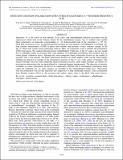DETECTING CHANGING POLARIZATION STRUCTURES IN SAGITTARIUS A* WITH HIGH FREQUENCY VLBI
Author(s)
Fish, Vincent L.; Doeleman, Sheperd Samuel; Broderick, Avery E.; Loeb, Abraham; Rogers, Alan E. E.
DownloadFish-2009-DETECTING CHANGING P.pdf (2.504Mb)
PUBLISHER_POLICY
Publisher Policy
Article is made available in accordance with the publisher's policy and may be subject to US copyright law. Please refer to the publisher's site for terms of use.
Terms of use
Metadata
Show full item recordAbstract
Sagittarius A* is the source of near infrared, X-ray, radio, and (sub)millimeter emission associated with the supermassive black hole at the Galactic Center. In the submillimeter regime, Sgr A* exhibits time-variable linear polarization on timescales corresponding to <10 Schwarzschild radii of the presumed 4 × 10[superscript 6] M[subscript ☉] black hole. In previous work, we demonstrated the potential for total-intensity (sub)millimeter-wavelength very long baseline interferometry (VLBI) to detect time-variable—and periodic—source structure changes in the Sgr A* black hole system using nonimaging analyses. Here, we extend this work to include full polarimetric VLBI observations. We simulate full-polarization (sub)millimeter VLBI data of Sgr A* using a hot spot model that is embedded within an accretion disk, with emphasis on nonimaging polarimetric data products that are robust against calibration errors. Although the source-integrated linear polarization fraction in the models is typically only a few percent, the linear polarization fraction on small angular scales can be much higher, enabling the detection of changes in the polarimetric structure of Sgr A* on a wide variety of baselines. The shortest baselines track the source-integrated linear polarization fraction, while longer baselines are sensitive to polarization substructures that are beam-diluted by connected-element interferometry. The detection of periodic variability in source polarization should not be significantly affected even if instrumental polarization terms cannot be calibrated out. As more antennas are included in the (sub)millimeter-VLBI array, observations with full polarization will provide important new diagnostics to help disentangle intrinsic source polarization from Faraday rotation effects in the accretion and outflow region close to the black hole event horizon.
Date issued
2009-11Department
Haystack ObservatoryJournal
Astrophysical Journal
Publisher
IOP Publishing
Citation
Fish, Vincent L., Sheperd S. Doeleman, Avery E. Broderick, Abraham Loeb, and Alan E. E. Rogers. “DETECTING CHANGING POLARIZATION STRUCTURES IN SAGITTARIUS A* WITH HIGH FREQUENCY VLBI.” The Astrophysical Journal 706, no. 2 (November 11, 2009): 1353–1363. © 2009 The American Astronomical Society
Version: Final published version
ISSN
0004-637X
1538-4357